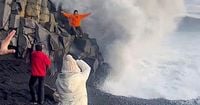On a bright September morning in Oceanside, California, 41-year-old Scott Muir paddled out with his friend Dan Pierson, ready to take on the hurricane-swollen waves rolling in from the Pacific. The ocean, whipped up by the distant but powerful category two Hurricane Narda, was alive with energy. For Muir—a seasoned surfer, devoted husband, father of two, and 12-year U.S. Air Force veteran—this was supposed to be just another exhilarating day chasing the surf.
But the ocean had other plans. As Muir caught what looked like a perfect wave, everything changed in an instant. “It threw me down headfirst and I heard this crunch. I couldn’t move anything. I was completely helpless,” he recalled to The Mercury News. In a split second, a vibrant life was upended: Muir had broken his neck and become paralyzed, trapped beneath the churning water.
Nearby, 19-year-old Judah Ely, who had met Muir only that morning, watched with growing alarm as Muir’s surfboard surfaced—but not Muir. “I’m looking for him and don’t see him come up, I just see the board. It took me a few seconds before I knew the severity. I was watching, waiting for him to come up and thought, ‘It shouldn’t take this long,’” Ely told the outlet. Then, he spotted the back of Muir’s head and shoulders floating. “This is bad,” Ely remembered thinking before springing into action.
Ely dove into the waves, fighting the current to reach Muir, who was barely visible and quickly disappearing again beneath the surface. After about 30 tense seconds, Ely reached the stricken surfer and managed to keep both their heads above water. “I was trying to keep my head above water, but most importantly, his,” Ely said.
Meanwhile, Ely’s friend Thomas Alspaugh, who had been surfing nearby, saw the rescue unfolding. Alspaugh’s junior lifeguard training kicked in. “We ripped off our leashes and started holding him in the right position to put the spinal board under him,” Alspaugh explained. “It was pretty instinctual. Because of what’s been programmed into me because of the junior lifeguard program, I knew what to do.”
With help from Pierson and other surfers, they stabilized Muir’s neck and kept him afloat until emergency personnel arrived. Paramedics quickly transported Muir to a local hospital, where he underwent emergency surgery for his broken neck. The procedure was successful—his spinal cord wasn’t severed, and he has since regained some movement in his arm and one leg. “I’m feeling optimistic and super loved,” Muir said. “That’s the reason he got me. Having good vibes in the water. It’s easy to forget that surfing is playing at the end of the day. That’s the only reason any of us are out there, to play in the water.”
Muir’s gratitude toward his rescuers is profound. Both Ely and Alspaugh visited him in the hospital. “To be able to look them both in the eye and say, like, you are the reason I get to see my wife again. You are the reason I get to see my daughter and my son,” Muir told KFMB. “I didn’t think I’d ever have that chance.”
Reflecting on the incident, Ely said, “If I wasn’t looking out for him and I wasn’t, like, being friendly, and he wasn’t being friendly, then so many things could have happened.” Their quick thinking and camaraderie made the difference between life and death.
The surfing community has rallied around Muir. A GoFundMe page set up to support his recovery—expected to take 12 to 18 months—has raised nearly $215,000 as of October 13, 2025. The outpouring of support is a testament to Muir’s impact as a father, husband, and the primary breadwinner for his family, as well as his service as a former captain of the U.S. Air Force Academy soccer team.
But Muir’s story is not an isolated one. The ocean’s beauty and power can be as deadly as they are alluring, a reality underscored by tragedies in places far from California’s sunny beaches. Thousands of miles away, on Iceland’s southern coast, the black sand beach of Reynisfjara draws tourists with its dramatic cliffs and pounding surf. Yet beneath its rugged charm lurk dangers that have claimed more than a few lives.
Recently, a man was swept away by a rogue wave at Reynisfjara while posing for a photo on a seaside ledge. A local photographer captured the terrifying moment, later posting: “Crazy that some people risk their lives for a photo.” The incident is just the latest in a string of tragedies at the beach, which is notorious for its unpredictable and powerful waves. In August 2025, a 9-year-old German girl drowned there after a sneaker wave inundated a cave she was exploring with her family. Two Estonian tourists who witnessed the event recounted, “They seem to have become trapped in this cave, the father and his daughters, and when the tide filled the cave, it took the younger girl with it.”
Warnings about Reynisfjara’s hazards are not new. As noted on the tourist information blog Guide to Iceland, “The waves here are so sneaky, they come creeping up on you and suck you in if you are standing too close—nothing can be done to save people if this happens—so please be extremely careful if you visit these beaches, and never turn your back to the sea and the waves.”
Despite signs and repeated cautions, the pattern continues: the ocean’s unpredictability catches even the most vigilant off guard. Whether in California, where hurricane swells can transform a day’s surf into a life-altering event, or in Iceland, where a simple photo op can turn deadly, the lesson is clear. Nature’s power is not to be underestimated.
For Scott Muir, the road ahead is uncertain but hopeful. He’s already begun to regain some movement, and his spirit remains unbroken. “I’m excited to one day surf with the two friends again,” he shared, looking forward to a day when the ocean’s call is answered not with fear, but with joy and respect.
From Oceanside’s sunlit waves to Reynisfjara’s shadowy shore, these stories serve as a stark reminder: the sea demands both awe and caution. For those who venture into its embrace, vigilance and community can mean the difference between tragedy and survival.




